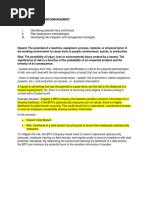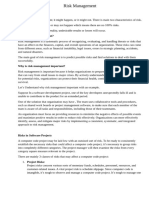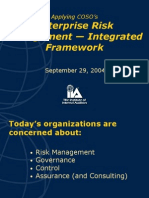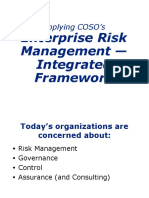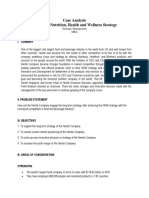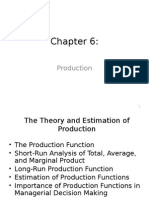Assessing Risk - Ensuring Internal Audit's Value
Assessing Risk - Ensuring Internal Audit's Value
Uploaded by
Michael BittleCopyright:
Available Formats
Assessing Risk - Ensuring Internal Audit's Value
Assessing Risk - Ensuring Internal Audit's Value
Uploaded by
Michael BittleOriginal Title
Copyright
Available Formats
Share this document
Did you find this document useful?
Is this content inappropriate?
Copyright:
Available Formats
Assessing Risk - Ensuring Internal Audit's Value
Assessing Risk - Ensuring Internal Audit's Value
Uploaded by
Michael BittleCopyright:
Available Formats
Assessing Risk: Ensuring Internal Audit’s
Value
Risk assessments in their various forms (e.g., annual audit planning,
engagement planning, enterprise risk management, etc.) are a key
building block for numerous internal audit activities, deliverables, and
communications such as periodic audit planning schedules, audit
engagement planning memos, audit reports, ERM activities, and audit
committee reports. However, many internal auditors and internal audit
functions struggle to find the right risk assessment framework that
balances stakeholder needs and resources available for this time-
intensive activity. Likewise, many internal auditors struggle with execution
of risk assessment activities such as establishing practical and consistent
measurement criteria for rating and ranking risks as well as keeping a
keen focus on the risks that are most important to their stakeholders. Risk
assessment is at the forefront of ensuring internal audit’s value to its
stakeholders. Without effective risk assessment activities, an internal
audit function has little assurance that it is deploying its resources in a
way that fulfills its mission within the organization.
This course provides practical insights relating to contemporary best
practices of risk assessment activities and allows participants to apply
what they have learned so that they can implement risk assessment
activities at their organization. This interactive and engaging two-day
course takes a deep dive into the fundamentals of risk assessment;
nuances such as audit universe, risk appetite, and fraud; and the
challenges of implementation. It also addresses skill gaps many internal
auditors struggle with such as how to develop their own risk assessment
frameworks and how to select or construct a risk ranking system. After
reviewing real examples of risk assessment models used by leading
internal audit functions, participants will have the opportunity to develop
their own risk assessment frameworks by picking and choosing those
elements and best practices that best meet the risk assessment needs of
their organization, no matter the size or maturity level of their internal
audit function.
Course Duration:
2 Days
CPE Hours Available:
16
Knowledge Level:
Advanced
Field of Study:
Auditing
Prerequisites:
Participants should have knowledge of common risk management
frameworks (such as COSO, CoCo, or Cadbury) and at least two years’
experience in internal auditing.
Advance Preparation:
None
Delivery Format:
Seminar, Online Virtual, On-site
Course Outline:
Nature of Risk
Explain the fundamental nature of risk.
Recognize patterns of change in an organization.
List potential changes that could impact organizational
opportunities and threats.
Recognize types and categories of risk.
Explain the strategic influences on risk assessment.
Risk Assessment Essentials
Identify the essential building blocks of a risk assessment.
Clarify internal audit’s role in risk management and risk
assessment with its key stakeholders.
Contrast various control framework risk assessment criteria.
Utilize a common vocabulary for discussing risk assessment
activities.
List the common risk assessment activities in which internal audit
functions have engaged historically.
Contemporary Risk Assessment Trends
Discuss contemporary trends relating to risk concerns of internal
audit stakeholders.
Trace the history of events and regulatory influences on
stakeholder perceptions and expectations concerning the role of
the internal audit function.
Describe the diversity of stakeholder needs for partnership in risk
assessment activities (past and present).
Recognize how legislation and regulatory activity have created
opportunities for internal audit to engage differently with
stakeholders (in regard to risk assessment activities).
Identify your organization’s risk-centric management maturity level.
Assess how your organization’s risk management maturity level
will impact your internal audit risk assessment approach.
Identify internal audit trends in regard to the risk focus continuum.
Discuss the results from The IIA Research Foundations’ 2010
Common Body of Knowledge (2010) that relate to risk
management and risk assessment.
The Audit Universe
Assess the completeness of the audit universe.
Identify auditable units to include in the audit universe.
Create an audit universe.
Validate the completeness of the audit universe.
Audit Universe Risk Assessment
Develop a risk assessment methodology for assessing the audit
universe.
Identify the objectives of the audit universe risk assessment.
Analyze examples of audit universe risk assessment
methodologies.
Determine the factors that influence the level of sophistication
needed for the risk assessment methodology.
Outline the audit universe risk assessment activities.
Examine techniques for risk identification and measurement.
Choose a method for prioritizing risk assessment results.
Discuss communication of risk assessment results with various
stakeholders.
Engagement Risk Assessment
Develop a risk assessment framework for engagement planning.
Identify the objectives of the engagement risk assessment.
Analyze examples of engagement risk assessment methodologies.
Determine the factors that influence the level of sophistication
needed for the risk assessment methodology.
Outline the engagement risk assessment activities.
Examine techniques for risk identification and measurement.
Choose a method for prioritizing risk assessment results.
Discuss communication of risk assessment results with various
stakeholders.
Fraud Risk Assessment
Perform a fraud risk assessment.
Identify the objectives of the fraud risk assessment.
Identify potential fraud schemes.
Prioritize potential fraud schemes base don risk.
Discuss communication of risk assessment results to various
stakeholders.
Risk Appetite
Integrate risk appetite into the risk assessment framework.
Define risk appetite.
Contrast various risk appetite and risk tolerance viewpoints.
Risk Assessment Implementation Challenges
Minimize risk assessment implementation issues.
Contrast the advantages and disadvantages of various risk
assessment models.
Identify solutions to common implementation issues.
Course Closing
Apply newly learned concepts, techniques, and skills to the work
place.
Restate major concepts, techniques, and skills learned during the
course.
Develop an action plan to apply select concepts, techniques, and
skills.
Identify additional resources to help stay current on issues related
to assessing risk.
You might also like
- Airbnb Case AnalysisDocument7 pagesAirbnb Case Analysisapi-34631431467% (3)
- 5 Risk Based AuditDocument93 pages5 Risk Based AuditAnonymous jlLBRMAr3O100% (1)
- Risk Appetite And Risk Tolerance A Complete Guide - 2020 EditionFrom EverandRisk Appetite And Risk Tolerance A Complete Guide - 2020 EditionNo ratings yet
- Webasto Case: Why Would Webasto Want To Create A New Innovation Process?Document2 pagesWebasto Case: Why Would Webasto Want To Create A New Innovation Process?RahulNo ratings yet
- CO4 - AUOPE Handouts - Risk AssessmentDocument6 pagesCO4 - AUOPE Handouts - Risk AssessmentTin CorderoNo ratings yet
- Best Practices in Planning and Conducting Risk-Based Internal AuditDocument5 pagesBest Practices in Planning and Conducting Risk-Based Internal Auditsheran23No ratings yet
- Chapter Four Demystifying Risk: Using Pmi PmbokDocument24 pagesChapter Four Demystifying Risk: Using Pmi Pmbokmeron berhanuNo ratings yet
- 5 6075868613338727912 PDFDocument40 pages5 6075868613338727912 PDFPrabhatNo ratings yet
- Task 1 UsmanDocument11 pagesTask 1 Usmansweet sweetNo ratings yet
- Lecture 7 RiskDocument59 pagesLecture 7 RiskSidra Majeed100% (1)
- Reviewing A Risk Management Framework: Comcover Information SheetDocument5 pagesReviewing A Risk Management Framework: Comcover Information SheetRHTi BDNo ratings yet
- Hermela Risk AssignmentDocument9 pagesHermela Risk AssignmentHermela tedlaNo ratings yet
- Risk Based Internal Auditing and ComplianceDocument4 pagesRisk Based Internal Auditing and Compliancejose10105No ratings yet
- Risk and Quality ManagementDocument3 pagesRisk and Quality ManagementAkash SharmaNo ratings yet
- RISK ASSESSMENT AND MANAGEMENT - ReportDocument9 pagesRISK ASSESSMENT AND MANAGEMENT - ReportCheasca AbellarNo ratings yet
- Chapter 6 - Risk ManagementDocument76 pagesChapter 6 - Risk Management--bolabolaNo ratings yet
- CRISC Course OutlineDocument6 pagesCRISC Course OutlinenainalasantoshNo ratings yet
- Risk Culture AuditsDocument3 pagesRisk Culture AuditsRona SilvestreNo ratings yet
- Risk Management ProcessDocument11 pagesRisk Management ProcessDebby Taylan-HidalgoNo ratings yet
- Workshop On: Implementing Enterprise Risk ManagementDocument6 pagesWorkshop On: Implementing Enterprise Risk Managementsheran23No ratings yet
- HEMP Lesson 3Document35 pagesHEMP Lesson 3sharleenkathomiNo ratings yet
- DF 6Document20 pagesDF 6THRISHA JINKALANo ratings yet
- Project Managemtn Sem 4Document8 pagesProject Managemtn Sem 4dhineshrajaaaNo ratings yet
- Occupational Risk (ISO 31000) & Fraud Risk Management 09 - 20 October 2023Document9 pagesOccupational Risk (ISO 31000) & Fraud Risk Management 09 - 20 October 2023khatibinhoNo ratings yet
- Risk Management in Covid Times: USING ISO 31000:2018 Principles in Ealing With A PandemicDocument43 pagesRisk Management in Covid Times: USING ISO 31000:2018 Principles in Ealing With A PandemicAnkurNo ratings yet
- CBOKDocument38 pagesCBOKBob Aldi100% (1)
- Domain 01 Risk Strategy and PlanningDocument6 pagesDomain 01 Risk Strategy and PlanningRawyaNo ratings yet
- Coso ErmDocument49 pagesCoso Ermmullazak100% (1)
- ACC451 Chapter 5 PowerpointDocument7 pagesACC451 Chapter 5 PowerpointMichael BurfordNo ratings yet
- Source and Evaluation of Risks: Learning OutcomesDocument34 pagesSource and Evaluation of Risks: Learning OutcomesNATURE123No ratings yet
- 6 - Audit PlanningDocument2 pages6 - Audit Planninggimata kochomataNo ratings yet
- Chapter 2 Source and Evaluation of Risks Annotated NotesDocument34 pagesChapter 2 Source and Evaluation of Risks Annotated NotesRoshan PednekarNo ratings yet
- Chapter 4 - Systematic Risk ManagementDocument22 pagesChapter 4 - Systematic Risk ManagementErmia MogeNo ratings yet
- Practical Guide To Risk Assessment (PWC 2008)Document40 pagesPractical Guide To Risk Assessment (PWC 2008)ducuh80% (5)
- Assignment Cover Sheet: Marking CriteriaDocument6 pagesAssignment Cover Sheet: Marking Criteriakabo busanangNo ratings yet
- Suggested Solution Case Study 2: Elective Paper 6A: Risk ManagementDocument3 pagesSuggested Solution Case Study 2: Elective Paper 6A: Risk ManagementChristen CastilloNo ratings yet
- Chapter 12 Project Risk ManagementDocument38 pagesChapter 12 Project Risk ManagementJaya ShresthaNo ratings yet
- Bec 3324: Project Management Year Iii - Semester Ii Session 7Document35 pagesBec 3324: Project Management Year Iii - Semester Ii Session 7Tharindu PereraNo ratings yet
- Assignment 1Document12 pagesAssignment 1Rania ElsarrafNo ratings yet
- Crisc SPRING 2013 Certified in Risk and Information Systems ControlDocument5 pagesCrisc SPRING 2013 Certified in Risk and Information Systems Controlmankrish6314No ratings yet
- 5th ChapterDocument14 pages5th ChaptermallelaharinagarajuNo ratings yet
- Coso ErmDocument49 pagesCoso ErmnasrciaNo ratings yet
- Lecture-6 RiskDocument51 pagesLecture-6 RiskZafar Farooq100% (2)
- A Risk Management StandardDocument17 pagesA Risk Management StandardRishabh JainNo ratings yet
- Dospueblos, Dej YDocument48 pagesDospueblos, Dej YDej DospueblosNo ratings yet
- Topic 5 Risk Management Process & Modelling Lecture 5Document29 pagesTopic 5 Risk Management Process & Modelling Lecture 5tahreekalfanNo ratings yet
- ERM - COSO Application TechniquesDocument113 pagesERM - COSO Application TechniquesAndika Buzz100% (5)
- Enterprise Risk Management - Integrated Framework: Applying COSO'sDocument49 pagesEnterprise Risk Management - Integrated Framework: Applying COSO'sTutu BazatuNo ratings yet
- Topic 8 Manage Project RiskDocument19 pagesTopic 8 Manage Project RiskEvonneNo ratings yet
- COSO FrameworkDocument47 pagesCOSO FrameworkMathew P. VargheseNo ratings yet
- Risk-Based Auditing - A Value Add PropositionDocument4 pagesRisk-Based Auditing - A Value Add PropositionHawkdollar HawkdollarNo ratings yet
- Risk Assessment GuideDocument40 pagesRisk Assessment GuideLeizza Ni Gui Dula100% (1)
- Chapter 4.docx SWDocument11 pagesChapter 4.docx SWkaffeNo ratings yet
- Unit Ii - Introduction To Risk ManagementDocument31 pagesUnit Ii - Introduction To Risk ManagementKumar KnNo ratings yet
- Essential Managed Healthcare Training for Technology Professionals (Volume 2 of 3) - Bridging The Gap Between Healthcare And Technology For Software Developers, Managers, BSA's, QA's & TA'sFrom EverandEssential Managed Healthcare Training for Technology Professionals (Volume 2 of 3) - Bridging The Gap Between Healthcare And Technology For Software Developers, Managers, BSA's, QA's & TA'sNo ratings yet
- Audit Engagement Strategy (Driving Audit Value, Vol. III): The Best Practice Strategy Guide for Maximising the Added Value of the Internal Audit EngagementsFrom EverandAudit Engagement Strategy (Driving Audit Value, Vol. III): The Best Practice Strategy Guide for Maximising the Added Value of the Internal Audit EngagementsNo ratings yet
- Risk Management And Compliance Risk A Complete Guide - 2020 EditionFrom EverandRisk Management And Compliance Risk A Complete Guide - 2020 EditionNo ratings yet
- Calling Script InformationDocument24 pagesCalling Script InformationGARRISON RECNo ratings yet
- IBDP Macroeconomics 3.2docxDocument21 pagesIBDP Macroeconomics 3.2docxSandeep SudhakarNo ratings yet
- Chap 010 ADocument11 pagesChap 010 AEdraNo ratings yet
- 11 Commerce SP QP PDFDocument2 pages11 Commerce SP QP PDFajayNo ratings yet
- Defining Social Accounting: Jack Quarter OISE, University of TorontoDocument32 pagesDefining Social Accounting: Jack Quarter OISE, University of TorontoritumahawalNo ratings yet
- Assignment 2Document13 pagesAssignment 2Lilian MichelNo ratings yet
- GSS 302 - Week 1-1Document8 pagesGSS 302 - Week 1-1Joseph IsraelNo ratings yet
- Ch1 - Master BudgetDocument38 pagesCh1 - Master BudgetProf. Nisaif JasimNo ratings yet
- Atul Education TYBCOM Marketing PointersDocument7 pagesAtul Education TYBCOM Marketing PointersSANTIAUNTI6 MENo ratings yet
- The Heckscher-Ohlin Model + Leontief Paradox SummaryDocument2 pagesThe Heckscher-Ohlin Model + Leontief Paradox SummaryAnaPaperina0% (1)
- Acc107 Quiz 2-P1Document9 pagesAcc107 Quiz 2-P1itsayuhthingNo ratings yet
- CURRICULUM VITAE Sabrina Dahmani - Updated 30 September 2018Document2 pagesCURRICULUM VITAE Sabrina Dahmani - Updated 30 September 2018sabryadahmaniiNo ratings yet
- Trading CompsDocument8 pagesTrading CompsLeonardoNo ratings yet
- Chapter 2Document5 pagesChapter 2Karl JimenezNo ratings yet
- Biological AssetDocument2 pagesBiological AssetMary Dale Joie BocalaNo ratings yet
- Porters Five Forces Analysis - 16 - 9Document4 pagesPorters Five Forces Analysis - 16 - 9Srinivas NandikantiNo ratings yet
- Accenture B-School Challenge - Consumer, Goods & Services - Case StudyDocument3 pagesAccenture B-School Challenge - Consumer, Goods & Services - Case StudyNakul VyasNo ratings yet
- AT Reviewer Part III (Questions and Answer) PDFDocument48 pagesAT Reviewer Part III (Questions and Answer) PDFVictor RamirezNo ratings yet
- Final Project ACC406 - Accounting SimulationDocument18 pagesFinal Project ACC406 - Accounting Simulationanisaqilahzainal100% (1)
- Geographics: 1. Market DemographicsDocument2 pagesGeographics: 1. Market DemographicsPhương Nguyễn Trường Xuân MaiNo ratings yet
- Nestle Sa - Nutrition, Health and Wellness StrategyDocument5 pagesNestle Sa - Nutrition, Health and Wellness StrategyJerald100% (1)
- CH6Document30 pagesCH6Fadi ChouNo ratings yet
- Title IXDocument4 pagesTitle IXDJ ULRICHNo ratings yet
- Plot The Troubling Trends For OTGDocument5 pagesPlot The Troubling Trends For OTGSalman ShaikNo ratings yet
- FAA - Unit 2 - 21 (Journal & TB)Document15 pagesFAA - Unit 2 - 21 (Journal & TB)Pranjal ChopraNo ratings yet
- Bom VSPD From 2010 Till Date Obtained Through Rti - PagenumberDocument48 pagesBom VSPD From 2010 Till Date Obtained Through Rti - PagenumberDIPAK VINAYAK SHIRBHATENo ratings yet
- 100 - Andi Tahmid Aswan.NDocument2 pages100 - Andi Tahmid Aswan.Nandi.22100No ratings yet
- MODULE 3.2 Social-Responsibility-and-Social-EntrepreneurshipDocument17 pagesMODULE 3.2 Social-Responsibility-and-Social-EntrepreneurshipDonna DuhigNo ratings yet














